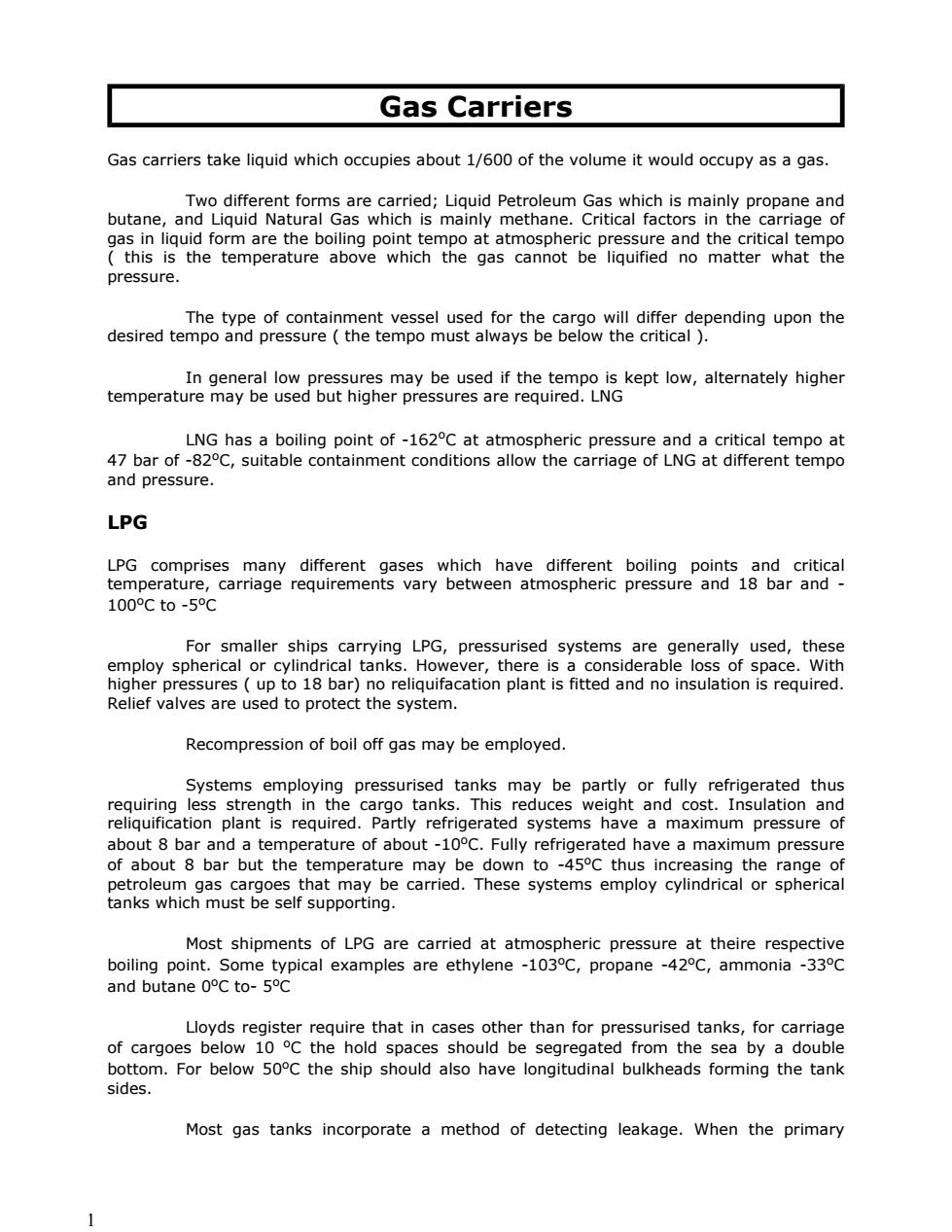正在加载图片...

Gas Carriers Gas carriers take liquid which occupies about 1/600 of the volume it would occupy as a gas. Two different forms are carried;Liquid Petroleum Gas which is mainly propane and butane,and Liquid Natural Gas which is mainly methane.Critical factors in the carriage of temperature above no matte In general low pressures may be used if the tempo is kept low,alternately higher temperature may be used but higher pressures are required.LNG LNG has a boiling point of-162C at atmospheric pressure and a critical tempo at 47 bar of-82C,suitable containment conditions allow the carriage of LNG at different tempo and pressure. LPG speanu5agegenenggyteheanrfnemerte5g8e29a8Rram 100°Cto-5°0 ror smaler shipa carying pressunsed systems are deneraly used,vith uifacation plant is fitted and no insulation is require Relief valves are used to protect the system. Recompression of boil off gas may be employed. Systems employing pressurised tanks may be partly or fully refrigerated thus Partly re ms ha Fully refrig maximum pressure 0 have a maximum pressure thus increa Most shipments of LPG are carried at atmospheric pressure at theire respective boiling point.Some typical examples are ethylene-103C,propane-42C,ammonia-33C and butane 0C to-59C Lloyds register require that in cases other than for pressurised tanks,for carriage of cargoes below 10 C the hold spaces should be segregated from the sea by a double bottom.For below 50C the ship should also have longitudinal bulkheads forming the tank sides. Most gas tanks incorporate a method of detecting leakage.When the primary 1 Gas Carriers Gas carriers take liquid which occupies about 1/600 of the volume it would occupy as a gas. Two different forms are carried; Liquid Petroleum Gas which is mainly propane and butane, and Liquid Natural Gas which is mainly methane. Critical factors in the carriage of gas in liquid form are the boiling point tempo at atmospheric pressure and the critical tempo ( this is the temperature above which the gas cannot be liquified no matter what the pressure. The type of containment vessel used for the cargo will differ depending upon the desired tempo and pressure ( the tempo must always be below the critical ). In general low pressures may be used if the tempo is kept low, alternately higher temperature may be used but higher pressures are required. LNG LNG has a boiling point of -162oC at atmospheric pressure and a critical tempo at 47 bar of -82oC, suitable containment conditions allow the carriage of LNG at different tempo and pressure. LPG LPG comprises many different gases which have different boiling points and critical temperature, carriage requirements vary between atmospheric pressure and 18 bar and - 100oC to -5oC For smaller ships carrying LPG, pressurised systems are generally used, these employ spherical or cylindrical tanks. However, there is a considerable loss of space. With higher pressures ( up to 18 bar) no reliquifacation plant is fitted and no insulation is required. Relief valves are used to protect the system. Recompression of boil off gas may be employed. Systems employing pressurised tanks may be partly or fully refrigerated thus requiring less strength in the cargo tanks. This reduces weight and cost. Insulation and reliquification plant is required. Partly refrigerated systems have a maximum pressure of about 8 bar and a temperature of about -10oC. Fully refrigerated have a maximum pressure of about 8 bar but the temperature may be down to -45oC thus increasing the range of petroleum gas cargoes that may be carried. These systems employ cylindrical or spherical tanks which must be self supporting. Most shipments of LPG are carried at atmospheric pressure at theire respective boiling point. Some typical examples are ethylene -103oC, propane -42oC, ammonia -33oC and butane 0oC to- 5oC Lloyds register require that in cases other than for pressurised tanks, for carriage of cargoes below 10 oC the hold spaces should be segregated from the sea by a double bottom. For below 50oC the ship should also have longitudinal bulkheads forming the tank sides. Most gas tanks incorporate a method of detecting leakage. When the primary 1